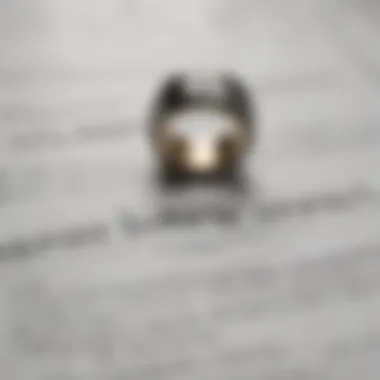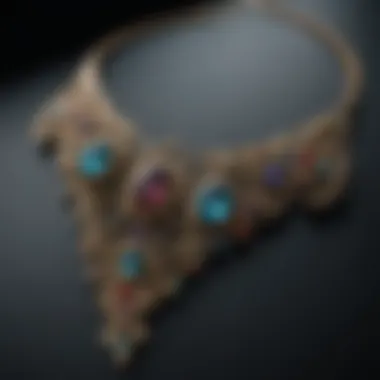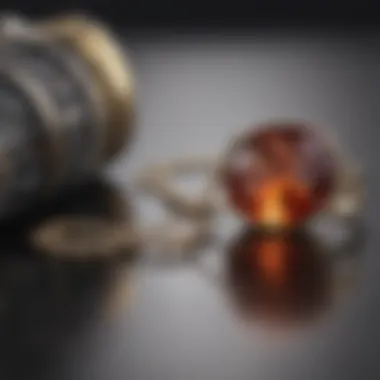Navigating Jewelry Coverage in Homeowners Insurance


Intro
Homeowners insurance serves as a crucial form of asset protection for many individuals. Among the items often included are valuable possessions such as jewelry. Understanding how this coverage works is vital. Jewelry can hold immense sentimental and material value, which raises questions about its protection under homeowners insurance.
In this article, we will explore how various policies approach jewelry coverage, examine common exclusions, and provide guidance for ensuring adequate protection of these cherished items. This exploration not only clarifies existing misconceptions but also aids in making informed decisions to safeguard one of life’s finer investments.
Overview of Insurance and Credit Card Options
Homeowners insurance traditionally covers personal property within the home, and jewelry can often fall under this umbrella. However, the degree of coverage may vary significantly based on the policy. It is important to comprehend the specific types of insurance that are available for jewelry and the role of credit cards in asset protection.
Types of Insurance Products
When considering homeowners insurance for jewelry, it’s useful to understand some common products:
- Basic Homeowners Insurance: This usually includes some level of protection for personal belongings, including jewelry. However, it may come with limitations on the total amount covered for valuable items.
- Rider or Endorsement: Homeowners can add a specific endorsement to their existing policy to secure more comprehensive coverage tailored to valuable items like jewelry. This is often advisable for expensive pieces.
- Scheduled Personal Property Insurance: A standalone policy that specifically covers listed valuable items individually. This type generally provides broader protection with fewer exclusions compared to standard homeowners insurance.
Credit Card Categories
In addition to insurance, certain credit cards offer minimal but relevant coverage options for jewelry.
- Premium or Luxury Credit Cards: Some of these cards provide purchase protection, which may cover jewelry against damage or theft for a specified period after purchase.
- Cards with Extended Warranty Programs: Users can benefit from extended warranty terms for covered items, which might include jewelry purchases.
Comparative Analysis
Acquiring knowledge about various homeowners insurance and credit card offerings is beneficial for making choices that align with assets’ value.
Comparison of Insurance Plans
It is crucial to compare different insurance policies and their approaches to covering jewelry.
- Limits on Coverage: Many plans specify caps on payouts for jewelry coverage. For instance, a policy may state a maximum of $1,000 for jewelry claims, requiring riders for higher amounts.
- Exclusions and Conditions: Common exclusions may apply, including loss under specific circumstances, such as mysterious disappearance.
Overview of Homeowners Insurance
Homeowners insurance serves as a fundamental safeguard for an individual's residence and immediate possessions. It offers a comprehensive risk management framework, securing homeowners against financial losses stemming from various hazards. Within this context, jewelry represents one such valuable asset, the protection of which can significantly impact financial stability.
Understanding homeowners insurance is critical for every homeowner, primarily because these policies not only provide security against theft or destruction but also define specific coverage areas relevant to personal property, including jewelry. With increasing value placed on individual assets such as jewelry, analyzing their coverage becomes essential.
Here are some notable reasons why homeowners insurance is significant:
- Protection Against Loss: Provides financial recovery options when unforeseen incidents occur such as theft or fire.
- Comprehensive Coverage: Encompasses numerous types of losses related to personal belongings.
- Peace of Mind: Allows homeowners to live without constant fear of a potential disaster.
"Insurance does not remove the risk, but it provides financial respite to manage the consequences of risk."
Understanding the structure and limitations of homeowners insurance ultimately equips the policyholder with the insights needed to protect their valuables accurately, including beloved jewelry. This knowledge proves beneficial in the event of a claim process, ensuring that individuals can retrieve their investments appropriately.
The Nature of Jewelry in Insurance Policies
Understanding the nature of jewelry in insurance policies is crucial to appreciating how these valuable items are treated under homeowners insurance. Jewelry represents not just material worth but also intrinsic value rooted in personal significance. Without clarity on how different policies approach jewelry, homeowners may not realize the true extent of their coverage or the limitations that could affect claims in times of need.
Classification of Jewelry


Jewelry can be broadly classified into different categories, which can influence its coverage in homeowners insurance. The primary classifications include:
- Fine Jewelry: This encompasses made items using precious metals and gemstones, such as diamonds and gold.
- Costume Jewelry: Often lesser in value, these pieces are typically fabricated using non-precious materials.
- Antique or Vintage Jewelry: This category contains items crafted in a past era, sometimes attracting higher personal and market value due to their rarity.
- Custom Jewelry: Pieces designed specifically for an individual often carry higher insurable values due to their unique attributes.
Having clear classifications allows policyholders to better assess whether their policies adequately cover their gemstones and accessories.
Intrinsically Valuable Items versus Sentimental Items
Jewelry can mean different things to different people, and understanding the distinction between intrinsically valuable items and sentimental items is key in homeowners insurance.
Intrinsically Valuable Items generally refer to pieces that hold market value based on their materials, construction, and brand. For example, a Rolex watch holds intrinsic value owing to the brand’s reputation and the quality of the materials used.
On the other hand, Sentimental Items might not carry a high market value but are priceless to the owner. A family heirloom passed through generations might have no market price but could mean everything to someone.
When evaluating homeowners insurance for jewelry, it is invaluable to distinguish between these types, as coverage may differ significantly. Many policies focus on the price of material value rather than that emotional price, which might lead to appreciating loss or underestimation at the time of filing a claim.
Coverage Limitations Related to Jewelry
Homeowners insurance can play a vital role in protecting valuable assets like jewelry. However, limitations in coverage can lead to significant challenges when filing claims after a loss. Understanding these restrictions is crucial for homeowners to ensure they are adequately protected. Therefore, it is essential to analyze not only the primary limits but also the nuances of different policies.
General Policy Limits and Extensions
Typically, standard homeowners insurance offers limited coverage for personal property, including jewelry. Most policies cap coverage for theft of jewelry to a specified amount, often around $1,500, depending on the insurer. This limit persists even if the contents of the house are otherwise fully covered.
This means if your wedding rings worth $5,000 are stolen, you only might be able to claim a fraction of their value under a standard policy.
Homeowners may pursue additional coverage options that specifically address jewelry. Requires an endorsement or a rider, which can extend a policy’s limits significantly. Scheduled personal property endorsements prioritize specific items. In essence, you can list your jewelry with an agreed value, creating a clear process when it comes to claims.
Comparing Different Types of Policies
Understanding the types of homeowners insurance policies available is fundamental to managing jewelry coverage effectively. There are generally three categories worth discussing: the Actual Cash Value (ACV) policies, Replacement Cost policies, and Named Peril policies.
- Actual Cash Value Policies: Losses are settled based on the item's current value minus depreciation. So, if you have a 10-year-old luxury watch, its replacement value may be far under your original purchase price.
- Replacement Cost Policies: Offers full payment to replace the item without deducting for depreciation, subject to coverage limitations. This is often advantageous for high-value jewelry.
- Named Peril Policies: Specifically list items covered under burglaries. Homeowners must review this list to understand potential exclusions.
Engaging with insurance experts can help unravel complexities. Properly comparing these policies is critical to find the best fit for one’s jewelry needs, avoiding unintended loss.
Understanding Exclusions and Considerations
Every insurance policy has its exclusions. Knowing these will assist homeowners in preparing for claims related to jewelry. Common exclusions may involve:
- Losses resulting from wear and tear: Daily usage where no crisis occurred might not lead to coverage.
- Theft of jewelry in a car or unattended area: This sometimes falls below coverage across various policies.
- Some natural disasters: Specific events often have their own exclusions, requiring homeowners to have additional protections.
Additionally, creating a precise and current inventory of jewelry with photographs enhances the clarity in case of claiming.
Evaluating jewelry coverage vis-à-vis homeowners insurance goes beyond perusal of the policy document. Homeowners should consistently update appraisals for high-value items. Combining efforts with professional associates offers huge benefits.
Understanding these policy limitations will lead to a more rounded sense of security, reducing the potential impacts of unexpected loss.
Additional Coverage Options for Jewelry
Exploring additional coverage options is important for homeowners insurance related to jewelry. Standard policies often have limitations, particularly when it comes to protecting high-value items. Using these additional options could offer proper protection and peace of mind.


Scheduled Personal Property Endorsement
The Scheduled Personal Property Endorsement provides a tailored strategy for covering valuable jewelry. This endorsement lets you list individual items along with their appraised value. By scheduling specific items, you ensure that they receive adequate coverage regardless of the general policy limits.
Filing the endorsement requires an appraisal. A professional assessment of the jewelry’s worth will save time during a claim process. Once scheduled, these pieces are covered for specific risks like theft or loss. Ensure regular updates as market value can change.
Personal Articles Policy
Another common option is the Personal Articles Policy. Unlike a homeowners policy, which covers broad types of loss, this specific policy focuses exclusively on high-value assets. It often features worldwide coverage without high deductibles, making it more advantageous for travelers and jewelry phase. Costs vary based on coverage amounts and restrictions can differ by provider.
This policy typically covers loss or damage caused by various issues. Keep in mind that certain risks such as wear and tear may still be excluded. Therefore, reviewing details is crucial.
Usage of Valuations for Claim Adjustments
Using valuations for claim adjustments plays a vital role in protecting jewelry assets. Accurate valuations help determine how much you would recover from an insurance claim. Should an item be lost, an updated valuation ensures fair compensation based on current market prices.
When filing a claim, provide clear evidence of valuations alongside purchase receipts. This documentation strengthens your case for compensation. Many insurance providers will require appraisals that are recent, often within the prior one to five years. Keeping precise records helps prevent misunderstandings during the adjustment process.
Claim Process for Jewelry Under Homeowners Insurance
Understanding the claim process specifically for jewelry under homeowners insurance is crucial. Many individuals assume that their insurance automatically covers all their belongings. However, jewelry can be treated differently. A proper understanding can prevent frustration during a challenging time.
The claim process serves as a structured pathway for policyholders to report a loss and seek restitution. This process ensures that policyholders adhere to specific guidelines laid out by insurance companies, enhancing the possibility of a successful claim.
Steps to File a Claim
Filing a claim for stolen or damaged jewelry follows a systematic process. Here are significant steps involved:
- Review Your Policy: Before taking action, review the relevant sections of your homeowners insurance policy to understand coverage limits.
- Notify Your Insurance Provider: Contact your insurer as soon as you notice a loss. Prompt notification is vital, as policies often stipulate a time frame for reporting losses.
- Obtain a Claim Number: Once you report the loss, the insurance company will assign a claim number.
- Provide Necessary Details: Describe how the loss occurred, providing as much detail as feasible. This may include when and where it happened, and if it was theft, possibly sharing the police report number.
- Submit Required Documentation: This is where the importance of documentation becomes apparent. See the subsequent section.
Following this methodical approach can simplify what may initially seem like a daunting task.
Documentation Required
To ensure a seamless claim process, specific documentation will be necessary:
- Proof of Ownership: Receipts, appraisals, or photographs help demonstrate that you own the jewelry in question.
- Assessments of Value: An up-to-date valuation from a certified appraiser may be essential, especially for high-value items. This can substantiate the worth during claim settlements.
- Claim Forms: Various insurance companies require standardized claim forms, which can typically be found on their websites.
- Detailed Account of the Loss: This includes a written statement of how the jewelry was lost or damaged, along with relevant dates and actions taken following the loss.
Recording and organizing this information promptly con contribute significantly to refining the claims process, reducing stress at what is already a challenging time.
Ensuring that you are well-prepared and equipped with the required documents and understanding of the steps involved will streamline the entire process of claiming for your jewelry under homeowners insurance.
Consequences of Underinsuring Jewelry
Underinsuring jewelry poses significant implications that homeowners should carefully consider. Insurance owners frequently underestimate the value of their jewelry or overlook essential factors influencing coverage. This results in inadequate protection during loss or damage events, where a claim may fall short.
Understanding the Risk of Loss
Each piece of jewelry holds a different level of risk for loss. Items may be lost through various events including theft, fire, or accidental damage. When jewelry is valued without proper assessments, the risks multiply. The responsibility lies with the policyholder to ensure their jewelry is valued accurately. Common misconceptions include evaluating jewelry at purchase price instead of current market value, which can lead to severe disparities during claims. By providing an air-tight assessment, homeowners arm themselves against potential losses.
Additionally, inherent risks may also rely on the context in which jewelry is utilized. Wearing expensive pieces out on special occasions may heighten the eens of loss. Homes without security systems may also increase vulnerability to theft; in fact, a simple statistical upswng states that homes with alarming systems could deter trespassers.


Proper insurance is not merely a checkbox; it is a strategic component of owning valuable items like jewelry.
Financial Impact of Insufficient Coverage
Inadequate coverage for jewelry can lead to unexpected and detrimental financial consequences. Should a situation arise where jewelry is irrevocably lost, and the insurance coverage is insufficient, policyholders could face a painful reality - a financial gap when replacing the beloved items. The emotional strain is compounded by the realization that financial recovery may not be possible due to uninsured losses.
This financial impact isn't solely tied to lost items either. When underinsurance happens, it is likely that claim settlements may not adequately cover repair costs when jewelry sustains damages. Essentially, this can result in the policyholders having to part ways with significant additional out-of-pocket expenses.
In summary, individuals must prioritize understanding their jewelry's worth and proper coverage amounts. Evaluating risks and financial losses involved proves crucial in making sound decisions. Evaluating coverage regularly, especially post-purchase, is as important as the acquisition process itself.
Tips for Evaluating Jewelry Coverage
Evaluating jewelry coverage is crucial for safeguarding valuable items. This section discusses important aspects to consider, the benefits of thorough evaluation, and key points to remember when planning your coverage.
Assessing the Value of Jewelry
Understanding the value of your jewelry is not just about knowing its market price. Factors like age, brand, and condition play significant roles. You should:
- Determine intrinsic value and emotional worth.
- Use high-quality appraisals to establish a fair market price.
- Continuously update valuations, especially after significant purchases or market fluctuations.
A proper assessment ensures adequate coverage. Underestimating value can lead to financial loss when claims occur. If your engagement ring is worth more than what is listed in your policy, you could face substantial out-of-pocket expenses if it gets lost or stolen.
Consulting with Insurance Experts
Insurance experts offer nuanced insights that are essential when evaluating jewelry coverage. Engaging professionals can provide guidance on:
- Identifying appropriate coverage types.
- Understanding common exclusions and limitations of policies.
- Tailoring coverage to unique pieces, including antiques or custom designs.
Consulting with knowledgeable agents helps mitigate potential risks associated with misunderstanding complex insurance jargon. They streamline the process of securing adequate coverage tailored to your specific needs and jewelry collection.
In addition, having these discussions can also lead to discovering additional options like riders or endorsements. These can further protect highly valued items. Collaboration with experts translates to informed decisions and a solidification of your jewelry’s protection.
Combining both thorough assessment and expert consultation results in a robust framework for recognizing risks in jewelry ownership and coverage competently. This organized approach aids in safeguarding your prized pieces against unforeseen events.
Current Trends in Jewelry Insurance
Jewelry insurance is increasingly relevant in modern times. People recognize the value of their jewelry, both monetary and sentimental. The recent years have seen shifts in market trends and consumer behavior. This article analyzes these developments to present key insights into jewelry coverage. Staying informed about the current landscape can provide better asset protection.
Market Shifts and Consumer Awareness
Understanding how the market for jewelry insurance is evolving is primary. More individuals, especially young professionals and families, are becoming aware of the necessity of protecting valuable possessions. Against a backdrop of rising crime rates and increased home insurance claims, the call to verify coverage is louder.
Statistics show that approximately 70% of homeowners don't hold adequate coverage for personal property. Rising emphasis on pairing valuable items like jewelry with appropriate insurance delivers a sense of security. Consumers become proactive after realizing the financial burden that loss or damage can induce. The importance of educating oneself on how to insure jewelry adequately cannot be overstated.
Some important aspects include:
- Increased online research: Consumers now leverage the internet to apprise themselves about insurance options.
- Social media outreach: Platforms like Facebook and Reddit serve as broadsheets for discussions about experiences regarding various insurance plans.
- Insurance technology: If used wisely, technology can confirm expected coverage without the hassle of visiting insurance offices.
Innovations in Valuation and Coverage
Emerging innovations are influencing how valuations occur. Traditional methods of insuring jewelry by lumping all items together are becoming outdated. Consumers now prefer specialized options catered to their exact needs.
- Advanced appraisals: Solutions exist for real-time valuation assessments, utilizing digital tools to create an accurate worth of jewelry pieces.
- Individual item listings: Insurers are creating flexibility in plans to allow customers to list specific pieces with utmost clarity.
- Smart technology integration: Items like smart rings or necklaces that track their respective sizes, parameters, and corresponding values further pave the way for tailored insurance.
Innovative coverage options contribute positively by tailoring plans to cover items accurately, reflecting their worth and significance. For insurance policies, adapting to changing valuations and spending habits is critical for maintaining a competitive edge in the market.
Innovation in jewelry insurance can mean the difference between recovering your item or facing major loss. Realizing how recent trends positively impact valuations fortify strategies to insure jewelry effectively.







